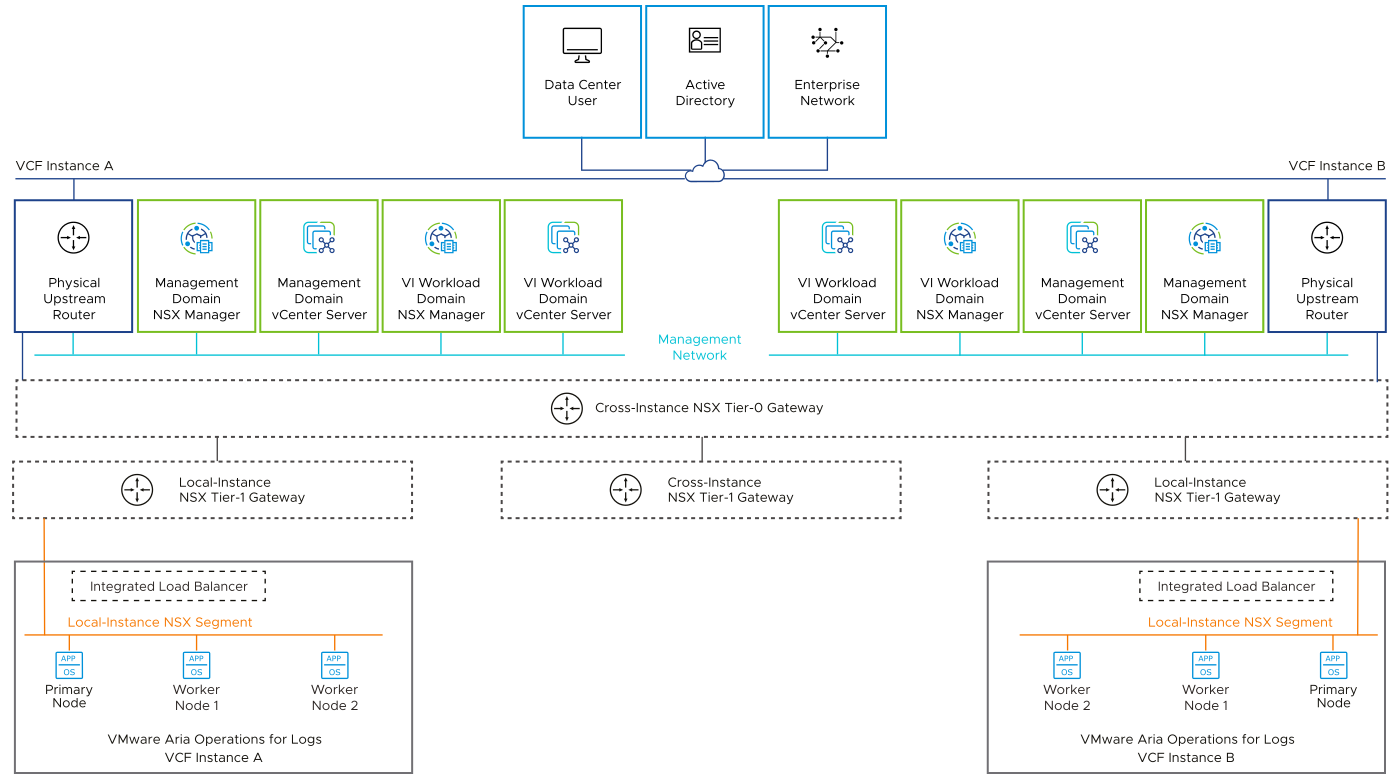In each VMware Cloud Foundation instance, for isolation and collocation with logging sources, the VMware Aria Operations for Logs cluster nodes are connected to the corresponding local-instance NSX segment.
Network Segments
The network segments design consists of characteristics and decisions for placement of VMware Aria Operations for Logs in the management domain.
For collection of logs locally, the VMware Aria Operations for Logs nodes are connected to the local-instance NSX segment in the corresponding VMware Cloud Foundation instance. This configuration ensures collection of logs locally per VMware Cloud Foundation instance if there is a cross-instance network outage.
Type |
Description |
|---|---|
Overlay-backed NSX segment |
The routing to the VLAN-backed management network segment and other networks is dynamic and based on the Border Gateway Protocol (BGP). Routed access to the VLAN-backed management network segment is provided through an NSX Tier-1 and Tier-0 gateway. Recommended option to provide scale out to a multi instance design supporting disaster recovery. |
VLAN-backed NSX segment |
You must provide two unique VLANs, network subnets, and vSphere distributed port group names. |

Decision ID |
Design Decision |
Design Justification |
Design Implication |
|---|---|---|---|
ILA-VAOL-NET-001 |
Place the VMware Aria Operations for Logs cluster nodes on the local-instance NSX network segment. |
Provides a consistent deployment model for management applications. |
You must use an implementation in NSX to support this networking configuration. |
IP Addressing
Decision ID |
Design Decision |
Design Justification |
Design Implication |
|---|---|---|---|
ILA-VAOL-NET-002 |
Allocate statically assigned IP addresses from the local-instance NSX segment to the VMware Aria Operations for Logs cluster nodes and the integrated load balancer (ILB). |
Ensures stability across the SDDC and makes it simpler to maintain and easier to track. |
Requires precise IP address management. |
IP Addressing for Multiple VMware Cloud Foundation Instances
Decision ID |
Design Decision |
Design Justification |
Design Implication |
|---|---|---|---|
ILA-VAOL-NET-003 |
In an environment with multiple VMware Cloud Foundation instances, allocate statically assigned IP addresses from each local-instance NSX segment to the VMware Aria Operations for Logs cluster nodes in the instance. |
Ensures stability across the SDDC and makes it simpler to maintain and easier to track. |
Requires precise IP address management. |
Name Resolution
Decision ID |
Design Decision |
Design Justification |
Design Implication |
|---|---|---|---|
ILA-VAOL-NET-004 |
Configure forward and reverse DNS records for all VMware Aria Operations for Logs cluster nodes and the integrated load balancer (ILB) VIP address. |
All nodes are accessible by using fully qualified domain names instead of by using IP addresses only. |
You must provide DNS records for the VMware Aria Operations for Logs nodes. |
Load Balancing
Decision ID |
Design Decision |
Design Justification |
Design Implication |
|---|---|---|---|
ILA-VAOL-NET-005 |
Enable the VMware Aria Operations for Logs integrated load balancer (ILB) for balancing incoming traffic. |
Supports balancing ingestion traffic among the VMware Aria Operations for Logs nodes and high availability. |
You must provide an extra IP address and FQDN for the integrated load balancer (ILB). |
Time Synchronization
Decision ID |
Design Decision |
Design Justification |
Design Implication |
|---|---|---|---|
ILA-VAOL-NET-006 |
Configure NTP on each VMware Aria Operations for Logs cluster node. |
VMware Aria Operations for Logs depends on time synchronization. |
None. |